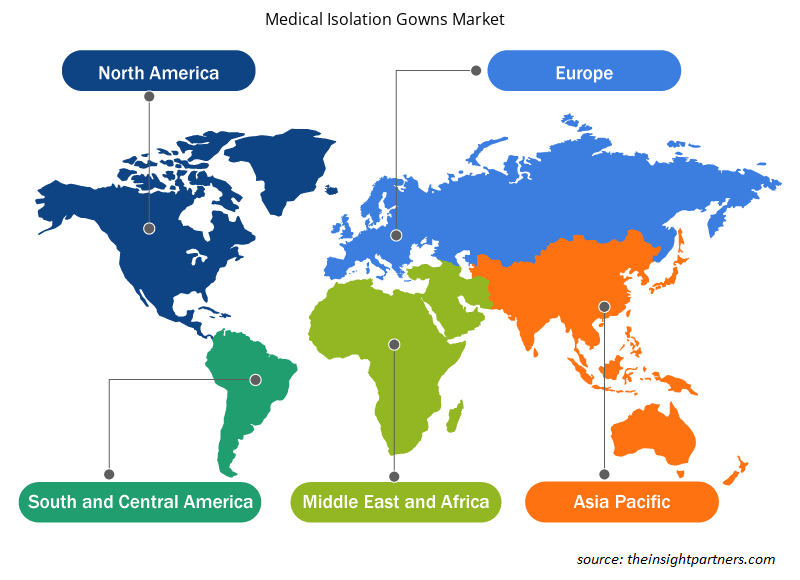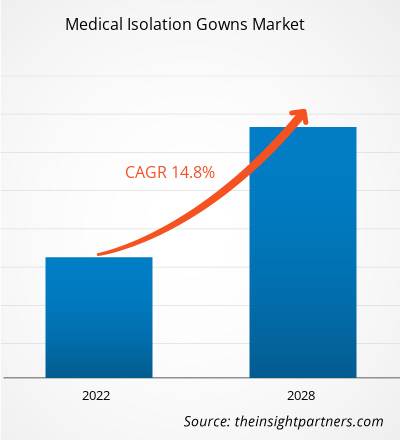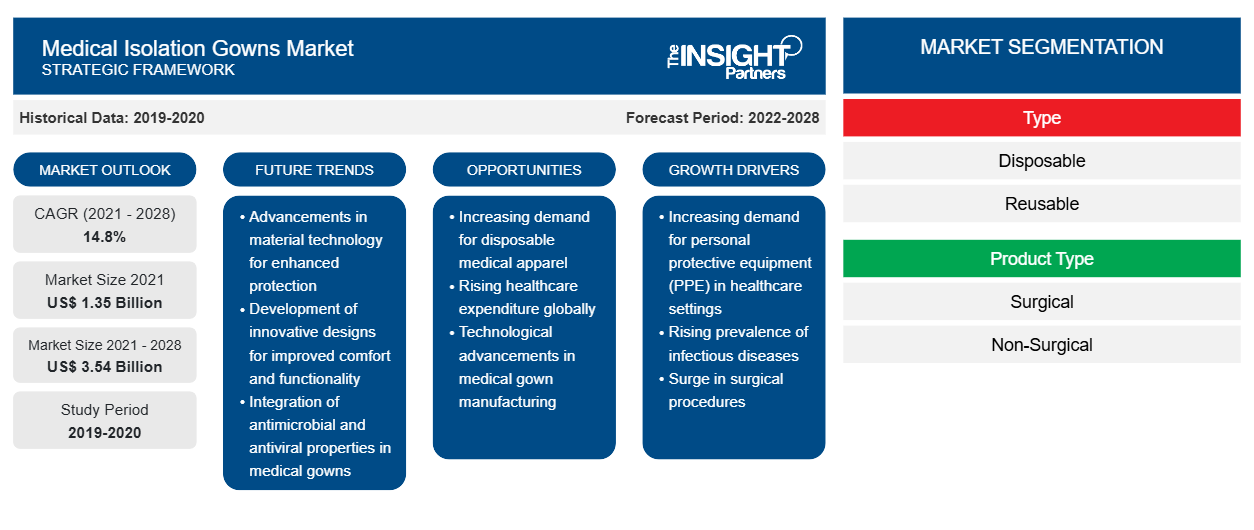Se espera que el mercado de batas de aislamiento médico alcance los US$ 3.542,78 millones para 2028 desde los US$ 1.346,31 millones en 2021; se estima que crecerá a una CAGR del 14,8% entre 2021 y 2028.
El informe ofrece información y un análisis profundo del mercado de batas de aislamiento médico , haciendo hincapié en varios parámetros, como las tendencias y oportunidades del mercado, la dinámica del mercado y el análisis del panorama competitivo de los principales actores del mercado en América del Norte, Europa, Asia Pacífico, América del Sur y Central, y Oriente Medio y África. También incluye el análisis del impacto de la pandemia de COVID-19 en las regiones.
Personalice este informe según sus necesidades
Obtendrá personalización en cualquier informe, sin cargo, incluidas partes de este informe o análisis a nivel de país, paquete de datos de Excel, así como también grandes ofertas y descuentos para empresas emergentes y universidades.
- Obtenga las principales tendencias clave del mercado de este informe.Esta muestra GRATUITA incluirá análisis de datos, desde tendencias del mercado hasta estimaciones y pronósticos.
Perspectivas del mercado
Aumentar la conciencia sobre las infecciones adquiridas en el hospital
Los pacientes contraen infecciones intrahospitalarias o asociadas a la atención médica (IAAS) mientras reciben servicios de salud en un hospital o en cualquier otro centro de atención médica. Los patógenos comunes, como bacterias, virus, hongos y parásitos, causan estas infecciones. Las IAS incluyen infecciones del tracto urinario asociadas a catéteres, infecciones del sitio quirúrgico (ISQ), infecciones del torrente sanguíneo asociadas a vías centrales, neumonía asociada a respiradores, neumonía adquirida en el hospital y varias otras infecciones. Muchos dispositivos quirúrgicos también pueden actuar como propagadores de IAS.
Las infecciones asociadas a la atención sanitaria tienen una alta tasa de morbilidad y mortalidad y cuestan al sistema sanitario miles de millones de dólares cada año. Los Centros para el Control y la Prevención de Enfermedades (CDC) informaron de que las infecciones asociadas a la atención sanitaria son responsables de unos 1,7 millones de casos de infección y 99.000 muertes cada año en los hospitales estadounidenses. Es obligatorio utilizar batas de aislamiento durante cualquier procedimiento médico en los centros sanitarios. Ayudan a prevenir la contaminación cruzada, la transferencia de fluidos corporales y cualquier microorganismo causante de infecciones y la penetración de líquidos. Las agencias gubernamentales, como la Red Nacional de Seguridad Sanitaria (NHSN) del Centro para el Control y la Prevención de Enfermedades (CDC), vigilan de cerca las infecciones que ayudan a prevenir las infecciones asociadas a la atención sanitaria y mejoran la seguridad de los pacientes. En los EE. UU., el Departamento de Salud y Servicios Humanos (HHS) trabaja para reducir los casos de infecciones asociadas a la atención sanitaria. Además, en Europa, la Red de Vigilancia de Infecciones Asociadas a la Atención Sanitaria (HAI-Net) vigila estas infecciones en la región, y la función de la HAI-NET está gestionada y controlada por el Centro Europeo para la Prevención y el Control de Enfermedades (ECDC). Por ejemplo, una encuesta titulada “Conocimiento de las infecciones asociadas a la atención médica entre los estudiantes de medicina en un centro de atención terciaria”, informó que un total de 82% (de 250) de los estudiantes estaban al tanto de las infecciones asociadas a la atención médica.
Perspectivas basadas en tipos
Según el tipo, el mercado de batas de aislamiento médico se divide en desechables y reutilizables. El segmento desechable tuvo una mayor participación en el mercado en 2021. Sin embargo, se estima que el segmento reutilizable registrará una CAGR más alta del 15,5 % en el mercado durante el período de pronóstico.
Información basada en el tipo de producto
Según el tipo de producto, el mercado de batas de aislamiento médico se divide en quirúrgicas y no quirúrgicas. El segmento quirúrgico tuvo una mayor participación del mercado en 2021. Sin embargo, se estima que el segmento no quirúrgico registrará una CAGR más alta del 15,1 % durante el período de pronóstico.
Las estrategias inorgánicas, como las fusiones y adquisiciones, son comúnmente adoptadas por las empresas para satisfacer las cambiantes demandas de los clientes y mantener sus marcas en todo el mundo. Los actores que operan en el mercado de batas de aislamiento médico también adoptan estrategias orgánicas, como el lanzamiento y la expansión de productos, para expandir su presencia y cartera de productos en todo el mundo, así como para satisfacer la creciente demanda.
Perspectivas regionales del mercado de batas de aislamiento médico
Los analistas de Insight Partners explicaron en detalle las tendencias y los factores regionales que influyen en el mercado de batas de aislamiento médico durante el período de pronóstico. Esta sección también analiza los segmentos y la geografía del mercado de batas de aislamiento médico en América del Norte, Europa, Asia Pacífico, Oriente Medio y África, y América del Sur y Central.

- Obtenga datos regionales específicos para el mercado de batas de aislamiento médico
Alcance del informe de mercado de batas de aislamiento médico
| Atributo del informe | Detalles |
|---|---|
| Tamaño del mercado en 2021 | 1.350 millones de dólares estadounidenses |
| Tamaño del mercado en 2028 | US$ 3,54 mil millones |
| CAGR global (2021-2028) | 14,8% |
| Datos históricos | 2019-2020 |
| Período de pronóstico | 2022-2028 |
| Segmentos cubiertos | Por tipo
|
| Regiones y países cubiertos | América del norte
|
| Líderes del mercado y perfiles de empresas clave |
|
Densidad de actores del mercado de batas de aislamiento médico: comprensión de su impacto en la dinámica empresarial
El mercado de batas de aislamiento médico está creciendo rápidamente, impulsado por la creciente demanda de los usuarios finales debido a factores como la evolución de las preferencias de los consumidores, los avances tecnológicos y una mayor conciencia de los beneficios del producto. A medida que aumenta la demanda, las empresas amplían sus ofertas, innovan para satisfacer las necesidades de los consumidores y aprovechan las tendencias emergentes, lo que impulsa aún más el crecimiento del mercado.
La densidad de actores del mercado se refiere a la distribución de las empresas o firmas que operan dentro de un mercado o industria en particular. Indica cuántos competidores (actores del mercado) están presentes en un espacio de mercado determinado en relación con su tamaño o valor total de mercado.
Las principales empresas que operan en el mercado de batas de aislamiento médico son:
- Salud Cardenal, Inc.
- Industrias Medline, Inc.
- Productos sanitarios Leboo Limited
- Sociedad Médica Narang Limitada
- Corporación Médica de Shanghái
Descargo de responsabilidad : Las empresas enumeradas anteriormente no están clasificadas en ningún orden particular.

- Obtenga una descripción general de los principales actores clave del mercado de batas de aislamiento médico
Por tipo
- Desechable
- Reutilizable
Por tipo de producto
- Quirúrgico
- No quirúrgico
Por el usuario final
- Hospitales
- Centros de cirugía ambulatoria
- Clínicas
- Otros
Por geografía
- América del norte
- A NOSOTROS
- Canadá
- México
- Europa
- Serbia
- Reino Unido
- Rusia
- Polonia
- Estonia
- Lituania
- Suecia
- Eslovaquia
- Finlandia
- Alemania
- Francia
- Italia
- España
- Resto de Europa
- Asia Pacífico
- Porcelana
- Japón
- India
- Australia
- Corea del Sur
- Resto de Asia Pacífico
- Oriente Medio y África
- Emiratos Árabes Unidos
- Arabia Saudita
- África
- Resto de Oriente Medio y África
- América del Sur y Central
- Brasil
- Argentina
- Resto de América del Sur y Central
Perfiles de empresas
- Salud Cardenal, Inc.
- Industrias Medline, LP
- Productos sanitarios Leboo Limited
- Sociedad Médica Narang Limitada
- Corporación Médica de Shanghái
- Atención sanitaria Mölnlycke AB
- Atención sanitaria Advin
- Dispotech S.r.L.
- Compañía Textil Estándar, Inc.
- PRIONTEX
- Sara Salud Pvt. Limitada.
- Análisis histórico (2 años), año base, pronóstico (7 años) con CAGR
- Análisis PEST y FODA
- Tamaño del mercado, valor/volumen: global, regional y nacional
- Industria y panorama competitivo
- Conjunto de datos de Excel
Informes recientes
Informes relacionados
Testimonios
Razón para comprar
- Toma de decisiones informada
- Comprensión de la dinámica del mercado
- Análisis competitivo
- Información sobre clientes
- Pronósticos del mercado
- Mitigación de riesgos
- Planificación estratégica
- Justificación de la inversión
- Identificación de mercados emergentes
- Mejora de las estrategias de marketing
- Impulso de la eficiencia operativa
- Alineación con las tendencias regulatorias























 Obtenga una muestra gratuita para - Mercado de batas de aislamiento médico
Obtenga una muestra gratuita para - Mercado de batas de aislamiento médico